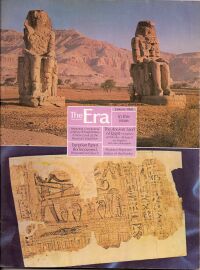
FAIR is a non-profit organization dedicated to providing well-documented answers to criticisms of the doctrine, practice, and history of The Church of Jesus Christ of Latter-day Saints.
| Answers portal |
| The Book of Abraham |
 |
|
FAQ:
Book of Abraham content: Production: |
|
==
A key assertion claimed by critics is that these documents were produced prior to the Book of Abraham manuscript, and that they therefore constitute a "smoking gun" that proves that Joseph was making up translations for Egyptian characters taken from the existing fragments of the Joseph Smith Papyri. Critics often refer to these papers as the "translation documents" for the Book of Abraham, and believe that they were used specifically to produce the first three verses in Abraham, Chapter 1.
==== For many years, the KEP were not well studied. A variety of possible explanations have been offered by LDS researchers over the years. The most recent approach postulates that the KEP represent an attempt by Joseph and his associates to create a way to encode revelations and other sensitive data in a form approximating "pure language." Research into this theory is ongoing. For the initial presentation of this theory, see William Schryver, The Meaning and Purpose of the Kirtland Egyptian Papers, August 2010 FAIR Conference. A number of the following paragraphs make use of conclusions made in this presentation.
The placement of a translation of the Book of Abraham prior to the production of the KEP renders Ashment's chronology, and the entire discussion regarding which document came before which other documents, irrelevant. The production of the KEP after the Book of Abraham indicates that the KEP does not represent "translation documents" documenting a physical process by which translation was attempted.
It should be noted that this does not change the relationship of the Book of Abraham to the Joseph Smith Papyri. It does not address the issue of whether or not the text of the Book of Abraham was actually present on the Scroll of Hor (the "long scroll" theory), or whether the scroll was simply a catalyst for revelation (the "short scroll" theory).
The earliest datable document in the collection is a letter from W. W. Phelps to his wife describing a selection of the "pure language". It is dated to May of 1835. The document contains a sequence of six characters, three of which may belong to a Masonic cipher. Each character is also given a name, a pronunciation and an explanation. However, what is significant is that all six of these characters appear in an identical order in other KEP documents, except they are given different names, sounds and explanations. None of these six characters come from the Papyri.
In the KEP, when a character in the Grammar is given multiple degrees, it does so usually by taking the source text and break it up into consecutive pieces. So, the first line might be the first degree, the second line the second degree, and so on. There is evidence that some of the source material in these explanations comes from sections of the D&C rather than the Book of Abraham.
The "Egyptian Counting" document which is part of the KEP, like the grammar documents, has a character, a sound, and an explanation for each, yet none of the characters are Egyptian. Nor do they contain a single character from the Joseph Smith papyri.
The historical record already confirms that efforts were made to encode certain things in order to prevent them from being read and understood by enemies of the Church. An effort to create such an encoding scheme using the KEP fits very well within the existing historical context. The Grammar seems to have been a project that suffered an early termination, and it was not pursued further.
====
The KEP do not lend support to the critical theory that the coherent words of the Book of Abraham were produced from a non-inspired analysis of the Egyptian materials before Joseph or his scribes. The text of the Book of Abraham was uttered by the Prophet and recorded by his scribes in much the same way that all of his revelatory translation projects were done. To the critic, this simply means that Joseph made up the coherent text and dictated it; to the believer, it means that Joseph received the text by revelation and dictated it, whether the actual text of the Book of Abraham existed on the papyri or not.

FAIR is a non-profit organization dedicated to providing well-documented answers to criticisms of the doctrine, practice, and history of The Church of Jesus Christ of Latter-day Saints.
We are a volunteer organization. We invite you to give back.
Donate Now